|
This is yet another of my unrealized
lifelong ambitions - building and flying an autogyro. The state of the art has advanced
significantly since the early garage-based and corporate experimenters. Companies
such as Autogyro USA sells a number of
models for private pilots with both open and fully enclosed cockpits. The Bensen
Autogyro was the craft du jour in the 1970s, with articles appearing in all the
handyman and airplane magazines of the day. My appetite was sufficiently whetted,
albeit well beyond the means of my meager paycheck. I vowed to build one when my
finances would allow. I'm going on 52 still waiting. There are quite a few model
autogyros flying with plenty of plans and a kit or two available if you would like
to build one. A simple Google search will locate them for you.
Here are two handfuls (10) of early models of both helicopters and autogyros
that, aside from the familiar Bensen, you might never have heard of.
More of Those Fabulous Mini-Copters
Photos and Text by Howard Levy
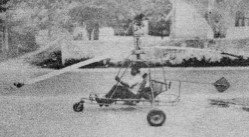 Jervis "Baby J," tiny 1-place jet-powered
under development in Bahamas Islands by L. G. Jervis. Constructed from airplane
junk pile, due to lack of parts and stainless steel on the island. Main fuselage
section is aircraft stretcher; tail boom 1/2" conduit; controls 3/8" water pipe;
rudder is radio base plate; B-29 hydraulic brake cylinder shaft is rotor shaft;
auto brake drum rotor head; ignition system from Model T; hand-barrow wheels on
landing gear. Powerplants are Jervis' own valveless design developing 100 lbs thrust
each, likewise from junk pile; B·29 hydraulic shaft makes up combustion chamber,
remainder consists of B-29 exhaust stacks, plus Texaco oil cans forming air intake
venturi. Fuselage length 7'; height 8'; empty weight 800 lbs; gross weight 600 lbs;
rotor dia. 20'; est. top speed 40 mph. Ground tested, made jump-like "free flight." Jervis "Baby J," tiny 1-place jet-powered
under development in Bahamas Islands by L. G. Jervis. Constructed from airplane
junk pile, due to lack of parts and stainless steel on the island. Main fuselage
section is aircraft stretcher; tail boom 1/2" conduit; controls 3/8" water pipe;
rudder is radio base plate; B-29 hydraulic brake cylinder shaft is rotor shaft;
auto brake drum rotor head; ignition system from Model T; hand-barrow wheels on
landing gear. Powerplants are Jervis' own valveless design developing 100 lbs thrust
each, likewise from junk pile; B·29 hydraulic shaft makes up combustion chamber,
remainder consists of B-29 exhaust stacks, plus Texaco oil cans forming air intake
venturi. Fuselage length 7'; height 8'; empty weight 800 lbs; gross weight 600 lbs;
rotor dia. 20'; est. top speed 40 mph. Ground tested, made jump-like "free flight."
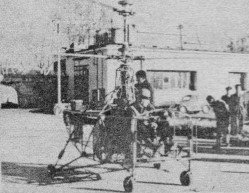
Manzolini-Bordoni "Libellula" (Dragonfly) single-place co-axial
configuration flown in Italy in '53. Powered by German 105 hp Hirth engine, cruising
speed of 65 mph; gross wt of 1430 lbs, rotor dia. 26'.
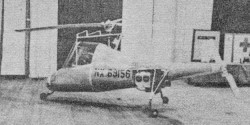 Helicopter Engine & Construction Corporation
Model 100 shown in '47; early attempt at tiny personal craft. Simplified flight
control system which eliminated separate cyclic and collective controls and pedals;
all controls combined on single stick, actuated similar to auto. 76 hp Continental
engine fitted with jet exhaust cooling system. Plywood construction; seated pilot
with 200 lb baggage. Rotor dia., 18', gross wt, 750 lbs; max. speed, 95-100 mph;
cruising, 80 mph; rate of climb, 1200 ft/min. Craft test flown; target price of
$5000 with mass production price of $2500; 2·seater proposed by raising rotor shaft
3', placing passenger section behind pilot. Neither craft produced. Helicopter Engine & Construction Corporation
Model 100 shown in '47; early attempt at tiny personal craft. Simplified flight
control system which eliminated separate cyclic and collective controls and pedals;
all controls combined on single stick, actuated similar to auto. 76 hp Continental
engine fitted with jet exhaust cooling system. Plywood construction; seated pilot
with 200 lb baggage. Rotor dia., 18', gross wt, 750 lbs; max. speed, 95-100 mph;
cruising, 80 mph; rate of climb, 1200 ft/min. Craft test flown; target price of
$5000 with mass production price of $2500; 2·seater proposed by raising rotor shaft
3', placing passenger section behind pilot. Neither craft produced.
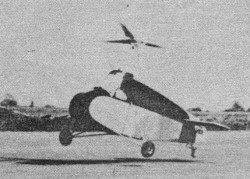 Eastern Rotorcraft Z-8 flown in 1948
was powerless "flying kite" requiring tow for sustained flight. Seated one, 24 ft
rotor dia. grossed 500 lbs. Built by Harris Campbell, Jack Marsh, Dick Huber, and
J. P. Perry of Pennsylvania . Eastern Rotorcraft Z-8 flown in 1948
was powerless "flying kite" requiring tow for sustained flight. Seated one, 24 ft
rotor dia. grossed 500 lbs. Built by Harris Campbell, Jack Marsh, Dick Huber, and
J. P. Perry of Pennsylvania .
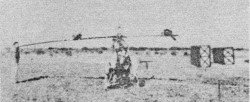 BENSEN "SKY SCOOTER" early '53 configuration.
Power supplied by two special engines mounted halfway on rotor blades similar to
Nagler-Rolz built in Austria during W.W.II. BENSEN "SKY SCOOTER" early '53 configuration.
Power supplied by two special engines mounted halfway on rotor blades similar to
Nagler-Rolz built in Austria during W.W.II.
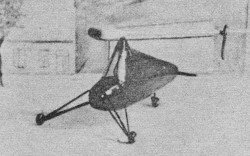 Nagler Single Blade Helicopter under
development in Austria '38·'42. Had single rotor blade 35' length counter-balanced
by 40 hp Czech-built Praga engine. Claimed to be first Single Blade helicopter built,
tested by full-scale whirl-stand ; prototype underwent tie-down hovering tests.
Destroyed during Allied bombing. Was 1-2 place, weighing 400 lb. empty, 770 lb.
at gross weight. Fuselage length 12'. German patent issued for design in '41 made
provision for utilization of rocket motor exhaust to actuate single blade rotor. Nagler Single Blade Helicopter under
development in Austria '38·'42. Had single rotor blade 35' length counter-balanced
by 40 hp Czech-built Praga engine. Claimed to be first Single Blade helicopter built,
tested by full-scale whirl-stand ; prototype underwent tie-down hovering tests.
Destroyed during Allied bombing. Was 1-2 place, weighing 400 lb. empty, 770 lb.
at gross weight. Fuselage length 12'. German patent issued for design in '41 made
provision for utilization of rocket motor exhaust to actuate single blade rotor.
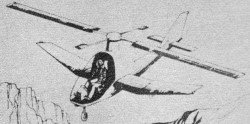 Monte-Copter Ultra-Light under development
for utility and personal use. Design calls for installation of Solar "Mars" gas
turbine developing 45 hp at 41,000 rpm. Utilizes pneumatic and jet drive, does not
have a conventional transmission gear or clutch. Empty wt, 430 lbs; gross wt. 910
lbs; top speed, 75 mph: endurance 2 hr; range 150 mi; service ceiling, 13,000';
rotor dia. 20', wingspan, 15'. Monte-Copter Ultra-Light under development
for utility and personal use. Design calls for installation of Solar "Mars" gas
turbine developing 45 hp at 41,000 rpm. Utilizes pneumatic and jet drive, does not
have a conventional transmission gear or clutch. Empty wt, 430 lbs; gross wt. 910
lbs; top speed, 75 mph: endurance 2 hr; range 150 mi; service ceiling, 13,000';
rotor dia. 20', wingspan, 15'.
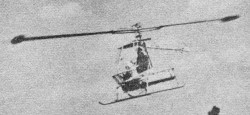 Dutch concern, Nederlandse Helicopter Industrie,
offers production prototype H-3 "Kolibrie." Improved version of their 1955 H-2 ramjet
copter. Empty wt. 450 lbs.; gross wt. 1325 lbs. Tip-mounted ramjets have separate
fuel supply, household kerosene is fuel. Extra fuel tanks between skids easily added
as well as optional cargo hook, litters, closed cabin, other equipment. Dutch concern, Nederlandse Helicopter Industrie,
offers production prototype H-3 "Kolibrie." Improved version of their 1955 H-2 ramjet
copter. Empty wt. 450 lbs.; gross wt. 1325 lbs. Tip-mounted ramjets have separate
fuel supply, household kerosene is fuel. Extra fuel tanks between skids easily added
as well as optional cargo hook, litters, closed cabin, other equipment.
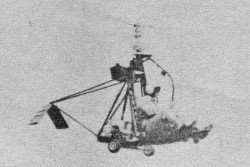 Navy version of Gyrodyne Rotoreycle XRON-1
shown in official "blues." See September 1956 issue for original presentation of
"Those Fabulous Mini-Copters" and data on this interesting American copter. New
"end plates" on rotor tips used for directional control are actuated by foot action.
Porche powerplant now being tested. Navy version of Gyrodyne Rotoreycle XRON-1
shown in official "blues." See September 1956 issue for original presentation of
"Those Fabulous Mini-Copters" and data on this interesting American copter. New
"end plates" on rotor tips used for directional control are actuated by foot action.
Porche powerplant now being tested.
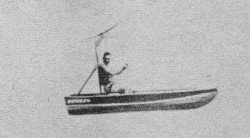 Bensen "Rotosail" flying attachment
can be added to any standard boat according to Igor Bensen (Bensen Aircraft Corp.,
Box 2725, Raleigh, N. C.). Do-it-yourself fans can build their own Rotosails from
construction plans available from BAC. Almost any rowboat, or an outboard, weighing
up to 200 lbs. can be made to "fly" under tow with the Rotorsail, reports Bensen,
but the lighter the boat, the better the performance. Bensen also designed Gyro-Glider
and Gyro-Copter. Bensen "Rotosail" flying attachment
can be added to any standard boat according to Igor Bensen (Bensen Aircraft Corp.,
Box 2725, Raleigh, N. C.). Do-it-yourself fans can build their own Rotosails from
construction plans available from BAC. Almost any rowboat, or an outboard, weighing
up to 200 lbs. can be made to "fly" under tow with the Rotorsail, reports Bensen,
but the lighter the boat, the better the performance. Bensen also designed Gyro-Glider
and Gyro-Copter.
Posted March 24, 2012
|